#the three principles of Islam
Explore tagged Tumblr posts
Text
Ancient Alchemy

Alchemy is one of the oldest mystical and proto-scientific traditions, blending philosophy, chemistry, spirituality, and metaphysics. It was practiced across multiple civilizations, including Egypt, Greece, China, India, and the Islamic world, each contributing to its development.
⚗Origins and Evolution of Alchemy
Ancient Egypt & Hermetic Alchemy (c. 2000 BCE - 300 BCE)
• Egyptian priests practiced early alchemical processes, such as metal purification and embalming.
• Thoth, later known as Hermes Trismegistus, was considered the patron of alchemy, giving rise to the Hermetic Tradition.
• The Emerald Tablet, attributed to Hermes, introduced the concept of “As above, so below,” suggesting the microcosm reflects the macrocosm.
Greek and Hellenistic Alchemy (c. 300 BCE - 400 CE)
• Greek philosophers like Empedocles and Plato theorized about the four classical elements (earth, water, air, and fire) as the building blocks of reality.
• The idea of the Quintessence (Aether) emerged as a mystical fifth element.
• Alchemy merged with Gnosticism and early Christian mysticism.
Indian and Chinese Alchemy (c. 400 BCE - 1200 CE)
• Indian Alchemy (Rasasastra) focused on immortality and transforming metals into gold, with mercury playing a key role.
• Chinese Alchemy (Neidan & Waidan) aimed at achieving the Elixir of Immortality, focusing on both external substances (Waidan) and internal spiritual practices (Neidan).
• Daoist alchemists sought balance through the Yin-Yang and the Five Elements.

Islamic and Medieval European Alchemy (c. 700 CE - 1600 CE)
• The Islamic world preserved and expanded alchemical knowledge, with figures like Jabir ibn Hayyan (Geber), who systematized laboratory techniques.
• Alchemy entered medieval Europe through translations, inspiring figures such as Albertus Magnus, Roger Bacon, and Paracelsus.
• The quest for the Philosopher’s Stone—a mythical substance granting immortality and transmuting base metals into gold—became central.
Renaissance and Early Modern Alchemy (c. 1500 - 1700 CE)
• The fusion of alchemy and early chemistry occurred through figures like Isaac Newton and Robert Boyle.
• Paracelsus emphasized spagyric alchemy, focusing on the medicinal applications of alchemy rather than purely transmutational goals.
• The rise of the Rosicrucians and Freemasons kept alchemical philosophy alive in esoteric circles.
⚗Core Principles of Alchemy
The Three Alchemical Principles (Tria Prima – Paracelsus)
Alchemy posits that all matter consists of three essential principles:
• Sulfur (Soul) – Represents spirit, transformation, and the volatile aspects of existence.
• Mercury (Mind) – Symbolizes fluidity, adaptability, and the connection between spirit and body.
• Salt (Body) – Embodies physical form and stability.

⚗The Four Classical Elements
Alchemy works with the foundational elements of Earth, Water, Air, and Fire, believing these are essential to transmutation and spiritual purification.
The Magnum Opus (Great Work)
The process of transmutation was divided into four symbolic stages:
• Nigredo (Blackening) – Death, dissolution, and breaking down impurities.
• Albedo (Whitening) – Purification and enlightenment.
• Citrinitas (Yellowing) – Awakening and the infusion of divine light.
• Rubedo (Reddening) – Completion, the birth of the perfected being, or the Philosopher’s Stone.
⚗Applications of Alchemy
Physical & Material Alchemy (Transmutation & Chemistry)
• Attempting to turn lead into gold symbolized the refinement of base matter into perfection.
• Alchemists developed early chemical processes, including distillation, sublimation, and crystallization, laying the groundwork for modern chemistry.
• Gunpowder, acids, and medicinal compounds were discovered through alchemical experiments.
Spiritual & Mystical Alchemy
• Many saw alchemy as a metaphor for spiritual enlightenment—transforming the “lead” of the mundane self into the “gold” of the divine self.
• The Philosopher’s Stone was also symbolic of self-realization and immortality.
• Theurgy and Hermetic practices integrated alchemy with ritual magick to invoke higher states of consciousness.
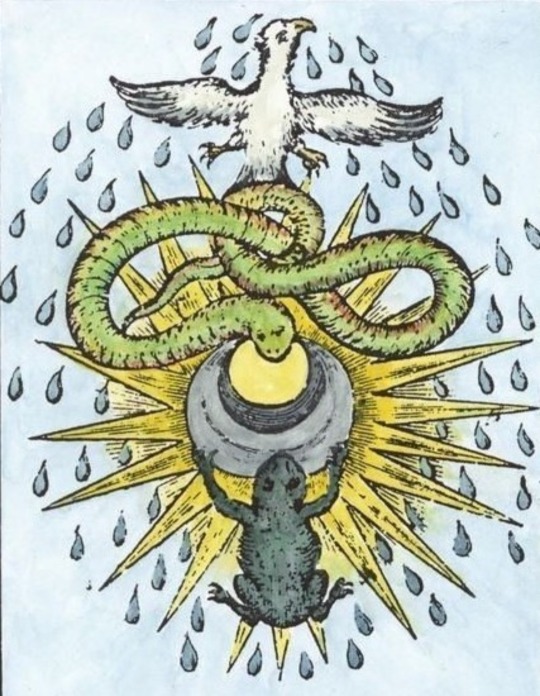
Medicine & Healing (Alchemical Medicine – Spagyrics)
• Paracelsus introduced the idea that diseases could be cured by extracting the essence of plants and minerals.
• Early homeopathy and herbal medicine developed from these alchemical principles.
• Some alchemists sought longevity elixirs, believed to extend life or even grant immortality.
Psychological Alchemy (Carl Jung’s Interpretation)
• Carl Jung saw alchemy as a metaphor for psychological individuation, where the Magnum Opus represented self-integration.
• The shadow (Nigredo), anima/animus (Albedo), and self-realization (Rubedo) were psychological processes paralleling alchemical transformation.
Occult and Modern Esoteric Alchemy
• Alchemical concepts remain central in Hermeticism, Thelema, Rosicrucianism, and Freemasonry.
• The idea of internal alchemy is found in modern spiritual traditions, focusing on energy work, ascension, and self-deification.
⚗Legacy of Alchemy in the Modern World
• Chemistry & Pharmacology: Many laboratory techniques originated from alchemical practices.
• Spiritual Development: The concept of personal transformation remains a key theme in occult traditions.
• Symbolism & Psychology: Alchemy’s symbols and processes influence Jungian psychology and self-improvement methodologies.
Alchemy is far more than just the pursuit of gold—it is a science of transformation at all levels: material, spiritual, and psychological. From its ancient roots in Egypt and China to its esoteric revival in modern mysticism, alchemy continues to inspire those seeking wisdom, power, and enlightenment.

#alchemy#Alchemist#Ancient alchemy#philosopher's stone#transmutation#transformation#magic circle#herbs#chemistry#science#history#esoteric#occult#eclectic witch#eclectic#pagan#magick#witch#witchcraft#witchblr#witch community#satanic witch#lefthandpath#chaos witch#chemicals#elements#as above so below#thoth#hermes#dark
165 notes
·
View notes
Note
Hey, I wanted to ask, do you have any tips for numbers and their meanings, For example: what does the number 5 represent?
Writing Notes: Symbolism of Numbers
In symbolism, numbers are not merely the expressions of quantities, but idea-forces, each with a particular character of its own.
The actual digits are, as it were, only the outer garments.
All numbers are derived from the number one (which is equivalent to the mystic, nonmanifest point of no magnitude).
The farther a number is from unity, the more deeply it is involved in matter, in the involutive process, in the“world.”
The first 10 numbers in the Greek system (or twelve in the oriental tradition) pertain to the spirit: they are entities, archetypes and symbols.
The rest are the product of combinations of these basic numbers.
Below are the most generally accepted symbolic meanings of each number.
ZERO
Non-being, mysteriously connected with unity as its opposite and its reflection; it is symbolic of the latent and potential and is the “Orphic Egg.”
From the viewpoint of man in existence, it symbolizes death as the state in which the life-forces are transformed.
Because of its circular form, it signifies eternity.
ONE
Symbolic of being and of the revelation to men of the spiritual essence.
The active principle which, broken into fragments, gives rise to multiplicity, and is to be equated with the mystic Centre, the Irradiating Point and the Supreme Power.
Stands for spiritual unity—the common basis among all beings.
Guénon draws a distinction between unity and one, after the Islamic mystic thinkers: unity differs from one in that it is absolute and complete in itself, admitting neither two nor dualism.
Hence, unity is the symbol of divinity.
Is also equated with light.
TWO
Stands for echo, reflection, conflict and counterpoise or contraposition; or the momentary stillness of forces in equilibrium; it also corresponds to the passage of time—the line which goes from behind forward; it is expressed geometrically by two points, two lines or an angle.
It is also symbolic of the first nucleus of matter, of nature in opposition to the creator, of the moon as opposed to the sun.
In all esoteric thought, two is regarded as ominous: it connotes shadow and the bisexuality of all things, or dualism (represented by the basic myth of the Gemini) in the sense of the connecting-link between the immortal and the mortal, or of the unvarying and the varying.
Within the mystic symbolism of landscape in megalithic culture, two is associated with the mandorla-shaped mountain, the focal point of symbolic Inversion, forming the crucible of life and comprising the two opposite poles of good and evil, life and death.
THREE
Symbolizes spiritual synthesis, and is the formula for the creation of each of the worlds.
Represents the solution of the conflict posed by dualism.
Forms a half-circle comprising: birth, zenith and descent.
Geometrically it is expressed by three points and by the triangle.
The harmonic product of the action of unity upon duality.
The number concerned with basic principles, and expresses sufficiency, or the growth of unity within itself.
Associated with the concepts of heaven and the Trinity.
FOUR
Symbolic of the earth, of terrestrial space, of the human situation, of the external, natural limits of the “minimum” awareness of totality, and, finally, of rational organization.
Equated with the square and the cube, and the cross representing the four seasons and the points of the compass.
A great many material and spiritual forms are modelled after the quaternary.
The number associated with tangible achievement and with the Elements.
In mystic thought, it represents the tetramorphs.
FIVE
Symbolic of Man, health and love, and of the quintessence acting upon matter.
Comprises the four limbs of the body plus the head which controls them, and likewise the four fingers plus the thumb and the four cardinal points together with the centre.
The hieros gamos is signified by the number five, since it represents the union of the principle of heaven (three) with that of the Magna Mater (two).
Geometrically, it is the pentagram, or the five-pointed star.
Corresponds to pentagonal symmetry, a common characteristic of organic nature, to the golden section (as noted by the Pythagoreans), and to the five senses representing the five “forms” of matter.
SIX
Symbolic of ambivalence and equilibrium, six comprises the union of the two triangles (of fire and water) and hence signifies the human soul.
The Greeks regarded it as a symbol of the hermaphrodite.
It corresponds to the six Directions of Space (two for each dimension), and to the cessation of movement (since the Creation took six days).
Hence it is associated with trial and effort.
Shown to be related to virginity, and to the scales.
SEVEN
Symbolic of perfect order, a complete period or cycle.
Comprises the union of the ternary and the quaternary, and hence it is endowed with exceptional value.
Corresponds to the seven Directions of Space (that is, the six existential dimensions plus the centre), to the seven-pointed star, to the reconciliation of the square with the triangle by superimposing the latter upon the former (as the sky over the earth) or by inscribing it within.
It is the number forming the basic series of musical notes, of colours and of the planetary spheres, as well as of the gods corresponding to them; and also of the capital sins and their opposing virtues.
Corresponds to the three-dimensional cross.
The symbol of pain.
EIGHT
The octonary, related to two squares or the octagon, is the intermediate form between the square (or the terrestrial order) and the circle (the eternal order) and is, in consequence, a symbol of regeneration.
By virtue of its shape, the numeral is associated with the two interlacing serpents of the caduceus, signifying the balancing out of opposing forces or the equivalence of the spiritual power to the natural.
It also symbolizes—again because of its shape—the eternally spiralling movement of the heavens (shown also by the double sigmoid line—the sign of the infinite).
Because of its implications of regeneration, eight was in the Middle Ages an emblem of the waters of baptism.
Corresponds in mediaeval mystic cosmogony to the fixed stars of the firmament, denoting that the planetary influences have been overcome.
NINE
The triangle of the ternary, and the triplication of the triple.
It is therefore a complete image of the three worlds.
The end-limit of the numerical series before its return to unity.
For the Hebrews, it was the symbol of truth, being characterized by the fact that when multiplied it reproduces itself (in mystic addition).
In medicinal rites, it is the symbolic number par excellence, for it represents triple synthesis, that is, the disposition on each plane of the corporal, the intellectual and the spiritual.
TEN
Symbolic, in decimal systems, of the return to unity.
In the Tetractys (whose triangle of points—four, three, two, one—adds up to ten) it is related to four.
Symbolic also of spiritual achievement, as well as of unity in its function as an even (or ambivalent) number or as the beginning of a new, multiple series.
According to some theories, ten symbolizes the totality of the universe—both metaphysical and material—since it raises all things to unity.
From ancient oriental thought through the Pythagorean school and right up to St. Jerome, it was known as the number of perfection.
ELEVEN
Symbolic of transition, excess and peril and of conflict and martyrdom.
According to Schneider, there is an infernal character about it: since it is in excess of the number of perfection—ten—it therefore stands for incontinence; but at the same time it corresponds, like two, to the mandorla-shaped mountain, to the focal point of symbolic Inversion and antithesis, because it is made up of one plus one (comparable in a way with two).
TWELVE
Symbolic of cosmic order and salvation.
It corresponds to the number of the signs of the Zodiac, and is the basis of all dodecanary groups.
Linked to it are the notions of space and time, and the wheel or circle.
THIRTEEN
Symbolic of death and birth, of beginning afresh.
Hence it has unfavourable implications.
FOURTEEN
Stands for fusion and organization.
And for justice and temperance.
FIFTEEN
Markedly erotic.
Associated with the devil.
OTHER NUMBERS
Tarot
Each of the numbers from sixteen to twenty-two is related to the corresponding card of the Tarot pack; and sometimes the meaning is derived from the fusion of the symbols of the units composing it.
There are two ways in which this fusion may occur: either by mystic addition (for example, 374 = 3 + 7 + 4 = 14 = 1 + 4 = 5) or by succession, in which case the right-hand digit expresses the outcome of a situation denoted by the left-hand number (so 21 expresses the reduction of a conflict—two—to its solution—unity).
These numbers also possess certain meanings drawn from traditional sources and remote from their intrinsic symbolism:
24, for example, is the sacred number in Sankhya philosophy, and
50 is very common in Greek mythology—there were fifty Danaides, fifty Argonauts, fifty sons of Priam and of Aegyptus, for example as a symbol, we would suggest, of that powerful quality of the erotic and human which is so typical of Hellenic myths.
Repetition
The repetition of a given number stresses its quantitative power but detracts from its spiritual dignity.
So, for example, 666 was the number of the Beast because 6 was regarded as inferior to seven.
Contained within a multiple
When several kinds of symbolic meaning are contained within a multiple number, the symbolism of that number is accordingly enriched and strengthened.
Thus, 144 was considered very favourable because its sum was 9 (1 + 4 + 4) and because it comprises multiples of 10 and 4 plus the quaternary itself.
Lastly: Dante, in the Divine Comedy, has frequent recourse to the symbolism of numbers.
Sources: 1 2 3
More: On Symbolism
Hope this helps, would love to read your writing if it does!
#symbolism#writing reference#dark academia#spilled ink#writeblr#writing prompts#literature#writers on tumblr#poets on tumblr#writing prompt#poetry#creative writing#numbers#light academia#fiction#novel#booklr#bookblr#writing resources
195 notes
·
View notes
Text
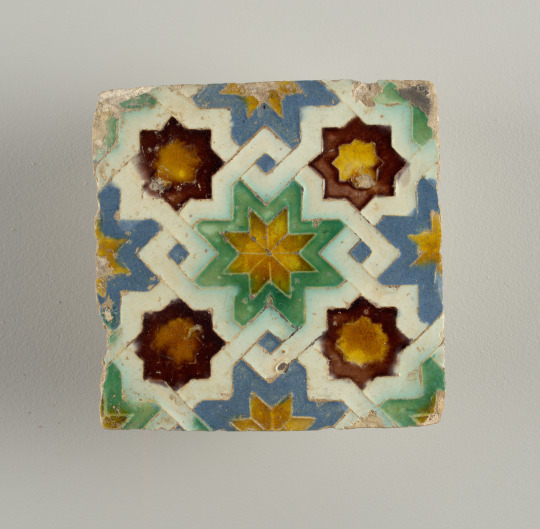



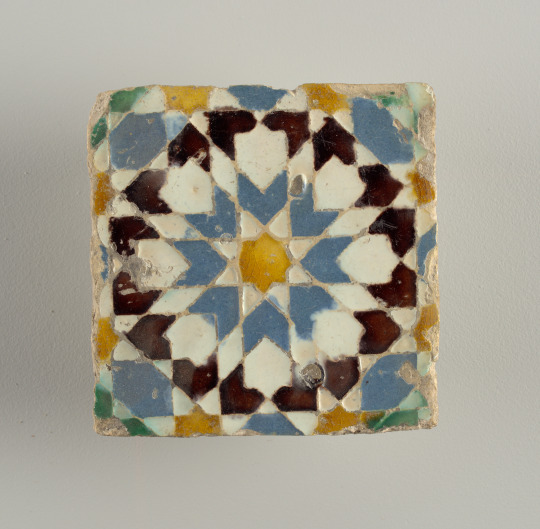
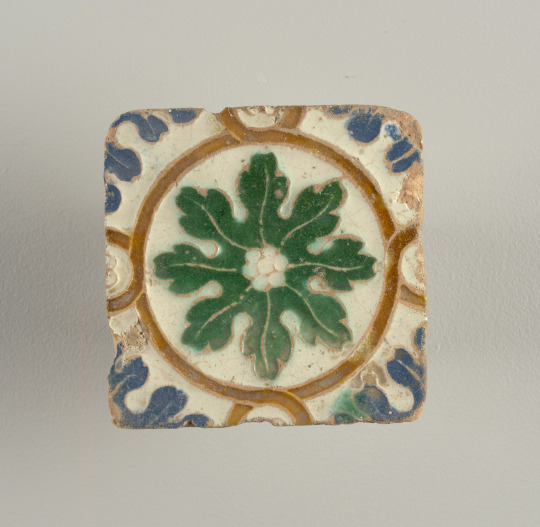

Tile(s) (Spain), 16th. century. Glazed moulded earthenware .
Likely dating from the early to mid sixteenth century, this tile illustrates Spain’s rich multicultural design history. Spain’s remarkable decorative pottery tradition originated during the eighth century when the country was conquered by the Moorish Muslim troops of North Africa as part of the expansion of the Umayyad Caliphate. This sixteenth-century tile shows how influential Islamic design principles were on Spanish pottery, even after the Reconquista—the period of the Moors conquest to their dethronement in the fifteenth century. The sixteenth century was also a time of transition for Spanish pottery. One can identify the influences of Flemish and Italian immigrants to Renaissance ideas and the continual impact of the country’s remaining Muslim population on Spanish pottery design. [1]
The white interlace motif on this tile creates a pattern of diamonds centered on an eight-pointed star in green and yellow. Strong color contrasts make the tile visually striking. This tile would have been one of countless others used to decorate a wall or ceiling in order to create an abstract and complex geometric pattern. Geometric patterning is a key visual element of Islamic art as one of three types of non-figural decoration along with calligraphic and vegetal patterns.
Although stylistically diverse, the visual complexity of all-over patterning is also seen in Spanish lustreware (referred to as Hispano-Moresque ware) and textiles from this period. This preference for all-over patterning can in part be attributed to Spanish decorative art’s intimate relationship with Islamic art and culture. In addition, this is the period when the country’s colonisation of the Americas further enriched Spain’s cultural complexity as is mirrored in both Spanish and Mexican Talavera pottery.
https://collection.cooperhewitt.org
90 notes
·
View notes
Text
Ugh, I've been meaning to post about this doll for what feels like ages! Allergies have been pretty bad this week, but I've finally been able to pull myself together enough to post about Fulla's prayer dolls!

According to the Islamic blog Alhannah.com, "The purpose of a prayer outfit is twofold – to respect the sanctity of prayer by covering one’s ‘Awrah’ (parts of the body that should be covered in public) and to uphold the principles of modesty".
"A prayer outfit typically encompasses a long, loose-fitting skirt paired with a top that has a head covering (Hijab), collectively ensuring that the body remains concealed during prayer". The website also states that there are one-piece and two-piece versions of the outfit, the choice between the two often coming down to preference of the wearer (in this case, it seems Fulla prefers the latter)

Muslims pray five times per day: once in the morning before dawn (Fajr), once at midday (Dhuhr), once in the afternoon (Asr), once after sunset (Maghrib), and once in the evening (Isha).
As far as I can find, there have been three prayer dolls of Fulla released. Two are for the Fajr and Isha prayers respectively, and one is for a process connected to all five!

Fulla's first prayer doll was released in 2004 with a doll-sized prayer mat and prayer beads for yourself!
Prayer mats are used to ensure the ground is clean while praying. Prayer beads, meanwhile, are used for dhikr, a process of prayer recitation after each of the five daily prayers. The beads are typically counted for each of the 99 names of Allah recited, however with certain prayer beads consisting of 33 beads instead (such as the one included here) they are counted 3 times over. The first 33 recitations are "Subhan Allah" (Glory be to Allah), the second 33 are "Al-Ahamdulilah" (Praise be to God), and the final 33 are "Allahu Akbar" (God is greatest). After these you must pray "Laa ilaha illallah wahdahu la sharika lah lahul mulku wa lahul hamdu wa huwa ala kulli shay in qadir" (There is no god worthy of worship except Allah alone, with no partner or associate) once.


Her next prayer doll was released in 2006 for the Morning Prayer (Fajr)! While I can't definitively say the same for the prior Prayer Dress Fulla, this doll wears indoor clothes underneath her prayer outfit to start the day! She comes with a prayer mat and bag, and (it says on the box but its hard to read) a prayer booklet of the Morning Prayers! And I hadn't even known this until now for this doll or the next, but apparently there's a button on her back that makes her recite them (batteries included)!
I like how much the pink pops against the white! Although the outfit is decent, it looks a bit plain compared to her other indoor looks (although that could have been intentional). I don't have any particularly strong feelings on her fashion, but it's decent!


The same year a doll for the Night Prayers (Isha) was released as well! Underneath her prayer clothes she wears a pair of pink pajamas with gingham detailing, with matching pink slippers! It seems she also came with a prayer mat, bag, and booklet (this time for the Night Prayers) as the Morning Prayers Fulla did! And yes, she also has a button to make her pray them with you!
I love these pajamas so much, they're so cute!!! And the way they match her prayer outfit too??? Indoor-fashion-wise, I probably prefer this one over the Morning Prayer's indoor outfit.
Overall, I love how all of these dolls not only represent a significant Islamic religious practice, but encourage children to do it with her! Between the prayer beads and voice button, I can easily see this doll joining in prayer with her owner :)
And not too difficult to imagine either, since Fulla has also made officially branded prayer clothes in 2005, 2007, and as recent as 2024!



Anyway, I'm glad I was finally able to dive deep into this topic like I'd been meaning to look into for a while (now to get some sleep as it is currently 4am)
Ramadan Kareem!
239 notes
·
View notes
Text
In order to explain in a few words, and without recourse to specialized linguistic knowledge, the specific nature of the Arabic language, let us first of all recall that every language has at its beginnings two poles, as it were, one of which comes to predominate without excluding the other. These two poles can be described by the terms "auditive intuition" and "imaginative intuition". Auditive intuition essentially identifies the meaning of a word with its quality as sound; this presents itself as the development of a simple phonetic formula which expresses a fundamental action such as "to unite", "to separate", "to penetrate", "to emerge", and so on, with all the physical, psychological, and intellectual polyvalence of which a type-action of this kind is capable. This has, moreover, nothing to do with semantic convention or onomatopoeia; the identification of sound and act is immediate and spontaneous, and in this regard, speech conceives everything it names as being basically an act or as the object of an act. Imaginative intuition, on the contrary, manifests itself in speech by the semantic associations of analogous images; every word pronounced evokes inwardly a corresponding image, which calls up other images, with the type-images dominating the more particular ones, according to a hierarchy that stamps itself, in its turn, on the structure of speech. The Latin languages are examples of this latter type, whereas Arabic discloses an almost untrammeled auditive intuition or phonetic logic, in which the identity of sound and act, as well as the primacy of action, are affirmed across the entire rich tissue of this language. In principle, every Arabic word is derived from a verb consisting of three invariable consonants, something like an aural ideogram, from which are derived as many as twelve different verbal modes—simple, causative, intensive, reciprocal, and so on—and each of these modes produces in its turn a plethora of nouns and adjectives whose first meaning is always linked, in a more or less direct way, to that of the fundamental action depicted by the trilateral root of the entire verbal "tree".
Titus Burckhardt, Art of Islam: Language and Meaning
#quote#Titus Burckhardt#Arabic#Burckhardt#Islam#Muslim#language#linguistics#English#perennialism#Islamic art#Sufism#calligraphy#Arabic calligraphy#sound#acoustics#theology
37 notes
·
View notes
Photo
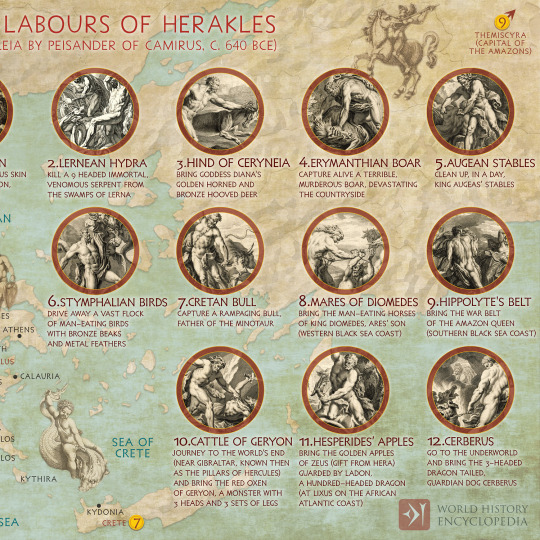
Key Numbered Lists in History
Throughout history, societies and traditions have used numbered lists to categorize and structure key concepts, figures, and beliefs. These lists often serve as mnemonic devices, aiding in the transmission of cultural, religious, and political knowledge across generations.
From the Seven Wonders of the Ancient World, which celebrated human architectural achievements, to the Five Pillars of Islam, which define core religious practices, such lists provide insight into the values and priorities of different civilizations. They can represent divine principles, as seen in the Eightfold Path of Buddhism and the Nine Muses, or political structures, such as the First Triumvirate of Rome and the Three Estates of pre-revolutionary France. Whether symbolic, philosophical, or historical, these enumerations continue to shape our understanding of the past.
Continue reading...
21 notes
·
View notes
Text
Cats have more freedom than women in Afghanistan, Hollywood actress Meryl Streep has said in an appeal to the international community to stop the Taliban's repression.
Speaking on the sidelines of the UN General Assembly, the actress pointed out that even animals had more rights now in Afghanistan following increased restrictions on women.
In response, a Taliban spokesman said they "highly respected" women and would "never compare them to cats".
Streep's comments come after the Taliban government last month introduced a new set of "morality laws".
Among other things, these rules state that women's voices can no longer be heard in public and that they are not allowed to look directly at men they are not related to by blood or marriage.
The measures add to a litany of restrictions that the regime has imposed on Afghan women and girls since returning to power three years ago.
Women have to completely cover their faces and bodies when leaving their homes. Women and girls are also prevented from going to schools, parks, gyms and sport clubs. There are restrictions on the type of work that they are allowed to do.
"Today in Kabul a female cat has more freedom than a woman. A cat may go sit on her front stoop and feel the sun on her face, she may chase a squirrel in the park," Streep said on Monday at an event to raise awareness of Afghan women's rights at the UN headquarters in New York.
"A squirrel has more rights than a girl in Afghanistan today because the public parks have been closed to women and girls by the Taliban.
"A bird may sing in Kabul, but a girl may not in public. This is extraordinary. This is a suppression of the natural law.
"The way that this culture, this society has been upended, is a cautionary tale for the rest of the world," said Streep, who called on world leaders to "stop the slow suffocation" of Afghan women and girls.
United Nations Secretary-General Antonio Guterres, who attended the same event, said Afghanistan "will never take its rightful place on the global stage" without educated women and women in employment.
In response to Streep's remarks, a Taliban spokesman said that "none can deny women the rights which Islam has given them".
"We highly respect them in their role as mother, sister, wife. They are [an] essential part of [the] family and society but we never compare them to cats," Suhail Shaheen, the head of the Taliban's political office, told the BBC.
He added that currently hundreds of thousands of women work in various government ministries and as entrepreneurs.
Western countries, led by the United States and the European Union, have condemned the new laws, but the Taliban has defended the edict saying it is in accordance with Islamic Sharia law.
The Taliban has also said they are trying to change the education system to more closely align with Islamic principles, and have repeatedly promised that women would be readmitted to schools once those issues are sorted. To date, however, there has not been any movement.
39 notes
·
View notes
Text
SPIRITUALITY IN ISLAM: PART 59: ILM (KNOWLEDGE)
Knowledge (‘ilm) means information obtained through the human senses or through the Revelations or inspiration of God.
It is also used to denote information that is in agreement with facts or realities, and to denote understanding something with its real, whole meaning and content. In addition, we come across usage of this term in the simple sense of thinking, under-standing, comprehension, and conclusions drawn as a result of such mental processes. Sometimes the word knowledge can even mean familiarity.
Although it is well known which aspect of the term knowledge in Islamic Sufism is most relevant in the context of this book, we deem it useful to mention some secondary matters, such as the different types of knowledge and its sources.
Knowledge, first of all, is dealt with in two categories: knowledge without means or knowledge that is had without being acquired, and knowledge that is acquired through some means.
Every living being has its own peculiar characteristics and potentials. These characteristics and potentials are the sources of certain, innate knowledge, knowledge a creature has without having to acquire it. (The modern scientific term for this kind of knowledge is instinct.) A human being’s being able to sense and perceive a lack of air, thirst, hunger, grief and joy, etc., a baby’s knowledge of how to nurse, a bird’s knowledge of how to fly and build nests, a fish’s knowledge of how to swim, young animals’ knowledge of how to avoid dangers, in short, these types of knowledge, knowledge of how to deal with the necessities of life, fall into the category of knowledge without means.
Knowledge acquired through the internal and external senses is included in the second category. Knowledge concerning the physical world is usually obtained through the five external senses-sight, hearing, smell, taste, and touch-while knowledge about the metaphysical or incorporeal realm of existence is acquired through internal senses-the mind and heart with their faculties of thought, reason, spiritual discovery and experience, intuition, etc.
As for the sources of knowledge or means of acquiring it, these consist of three, according to Islam:
The five external senses, provided they are sound.
True reports, of which there are two kinds: reports unanimously given by a group of truthful people of such a number that it is inconceivable that they have agreed to lie, and reports given by the Messengers of God, whom He has sent with special messages.
The third source of knowledge is reason. Axiomatic knowledge and the knowledge reached by using the mental faculties are included in this kind of knowledge.
Knowledge is also divided into two groups: that which is acquired through the mental faculties, and that which is reported knowledge. The first can be divided up into three categories:
Knowledge of such matters as health and education, which in Islam are regarded as incumbent upon every individual or a group of people in the community, according to the time and conditions.
Another kind of knowledge acquired through the mental faculties is knowledge of which Islam disapproves. Sorcery, divination and occult sciences are of this kind.
Sciences, such as geometry, mathematics, medicine, physics, chemistry, and history are included in the third category, the study of which Islam regards as obligatory on the community in order to discover God’s laws of the creation and operation of the universe and for the well-being of the community.
Reported knowledge is of two kinds: knowledge based on spiritual discovery and inspiration and knowledge concerning Islam and Islamic life. The second kind has been separated under four heads:
The knowledge of the fundamental principles, which include knowledge of the Qur'an, Sunna (the Prophet’s way of life, sayings, and confirmations), the consensus of the scholars (ijma’) and analogy or deductive reasoning. These are the sources upon which the rules of the Shari'a are based.
The knowledge of the subdivisions, which includes the knowledge of worship (the Prescribed Prayer, the Prescribed Alms-giving, Fasting, Pilgrimage and so on), the daily life of the believers, marriage and relevant matters, such as divorce and alimony (civil law), and legal penalties (criminal law), etc.
Primary sciences, such as language, grammar, meaning, composition, and eloquence, which are ways to properly understand the religious sciences, such as Hadith (the sayings of the Prophet), the interpretation of the Qur'an, and jurisprudence.
The complementary or secondary sciences, i.e. the sciences additional to the sciences of the Qur'an. They consist of sciences relating to the wording and composition of the Qur'an, such as phonetics and recitation; the sciences pertaining to its meaning, such as interpretation and exegesis, and those relating to its commandments, such as the abrogating and the abrogated, the general and particular, the explicit and implicit, the real or literal and the metaphorical or allusive, the succinct and the detailed, the clear and the ambiguous, the direct and firm and the allegorical.
As for reported knowledge based on spiritual discovery and inspiration, it has also been dealt with under two heads: the knowledge that occurs in one’s heart as a gift from God, and the knowledge that arises in the conscience. What we will study among the topics of the “Emerald Hills of the Heart” is this kind of knowledge. Whether it is of the kind occurring in one’s heart as a gift from God or of the kind arising in the conscience, this knowledge is and must be based on the Qur'an and the Sunna. Any knowledge one finds in one’s heart or conscience which has not been filtered through these two pure sources is not reliable. It cannot be binding knowledge for either the individuals themselves or others, it cannot be considered as authentic, sound knowledge. This important point has been stressed by many great Sufi leaders. For example:
Junayd al-Baghdadi says: “All the ways that do not end in the Prophet are closed and do not lead to the truth.” He also reminds us: “Anyone who does not know the Book and the Sunna is not to be followed as a guide.”
Abu Hafs explains: “Anyone who does not continually control him or herself in the light of the Book and the Sunna cannot be regarded as belonging to this way.”
Abu Sulayman al-Darani warns: “I admit the truth of whatever occurs to the heart only provided it is confirmed by the Book and the Sunna.”
Abu Yazid al-Bistami admonishes: “I struggled against my carnal self for almost thirty years and did not find anything more difficult for it to accept than the objective criteria of the Book and the Sunna. You should not be misled by anyone, even if they work wonders like flying through the air, rather you should consider their care in observing the limits set up by the Shari'a and following the commandments of the Book and the Sunna.”
Abu Sa'id al-Harraz sums up the matter: “Any intuitive knowledge which is not compatible with the spirit of religion is false.”
Abu al-Qasim Nasrabadi teaches: “The essence of the Sufi way is strict adherence to the Book and the Sunna, holding back from the misleading inclinations of the carnal self and innovations in religion, being able to overlook the faults of others, not becoming negligent in one’s daily recitations to glorify and praise the Almighty, being strict in fulfilling the religious commandments without applying special exceptions, and refraining from personal, insubstantial opinions regarding religion.”
The Sufi leaders give knowledge precedence over the spiritual state of the Sufis, because that state depends on knowledge. Knowledge is the heritage of the Prophets, and the scholars are the heirs thereto. The Prophetic saying, “The scholars are the heirs of the Prophets,“ is the highest of the ranks recognized for scholars.
The knowledge of the truth or knowledge that leads to the truth is the life of the heart, the light of the eye, the cause of the expansion of the breast (with peace, exhilaration, and spiritual happiness), the stimulus to activate reason, the source of pleasure for the spirit, the guide of those bewildered as to which way to follow, the intimate friend of the lonely, and an invaluable table of heavenly foods offered on the earth and one to which the angels show great respect.
Knowledge is an important step toward belief, a standard to distinguish between guidance and error and between certainty and doubt, and a Divine mystery manifesting the truly human aspects of a person.
There is no exaggeration in the following saying of a friend of God:
A human being is truly human with knowledge;
But without knowledge is entirely bestial.
Action without knowledge is purely ignorance;
So, O friend, you cannot find the Truth without knowledge.
By knowledge, the Sufis mean, rather than the familiarity that is reached with the mind, hearing and sight, the light and radiation that come from the realms beyond the material world and have their source in God’s Knowledge. This light pervades the spirit and bursts like flowers in the meadows of the innermost faculties of the person, and swells and flows in the gifts of the All-Eternal One. In order to be able to receive this Divine gift, one should, first of all, turn with all one’s inner world to the Eternal Sun and, freed from the influences of the body and carnal pleasures, lead a life at the level of heart and spirit, and open one’s breast to God, the Truth, with belief, love, and attraction, and then one should be able to rise to a level where one can be taught by God through inspiration.
As declared in the Divine declaration (18:65),
We taught him knowledge of a special kind from Our Presence, God-inspired knowledge is the rain of mercy that pours down into the depths of a person’s inner world from the Realm of the Holy Presence- the Realm where those who are the nearest to God experience His Holy Presence-without any intermediary and veils. Deep devotion to God, sincere adherence and loyalty to Him as well as the Messenger, being sincerely well-pleased with whatever God decrees or causes to happen for one and trying to please Him, the sincerity and purity of intention in one’s acts or doing whatever one does only to please Him and because He wants us to do it, and having a heart pursuing certainty in the matters of belief over and over again-all this is what is required to be rewarded with God-inspired knowledge, especially in abundance.
Since the Prophets received Divine Revelation and were taught by Him, their knowledge is a God-inspired knowledge that comes from Him without any intermediary. As for the knowledge of purified, saintly scholars and other saintly persons, this is also a God-inspired knowledge, the only difference being that the source is the rays of light of the Prophetic knowledge. Khadr is regarded as the foremost one in receiving this knowledge. However, he can only be so regarded for a certain period of time and spiritual rank and for the state particular to him. In certain particular matters, some people may be superior to those who are superior to them in general terms. Similarly, in certain particularities of God-inspired knowledge, Khadr is superior to those who are greater than him. He is in no way superior to either the Prophet Moses, upon him be peace, or the other great Messengers.
As a Messenger charged with teaching people God’s commandments and guiding them in their lives so that they could attain happiness in both worlds, the Prophet Moses knew God’s commandments concerning the human individual and social life and the sensitive relation between them and the outward and inward aspects or dimensions of things. But, Khadr’s knowledge is restricted to the inward dimension of things. He points to this difference in his conversation with Moses:
“Moses! I have a kind of knowledge which God has taught me and you do not possess, while you have another kind of knowledge which God has taught you and I do not possess.”
In conclusion, God-inspired knowledge is the kind of knowledge which one cannot acquire by studying or being taught by others. It is a special gift from God and a kind of illumination, from a sacred source, that one finds in one’s heart. Rather than being the kind of knowledge about the Creator acquired by studying creation and which therefore leads from the created to the Creator, it is a kind that pours from the Maker to the conscious “works” of His art. It is even regarded as the emergence in the human spirit of the knowledge about some mysteries pertaining to God, the Truth, as special gifts from Him.
Anyway, it is always God Who knows best the truth in every matter.
#allah#god#islam#muslim#quran#revert#convert#convert islam#revert islam#revert help#reverthelp#revert help team#help#hadith#islamhelp#converthelp#how to convert to islam#convert to islam#welcome to islam
15 notes
·
View notes
Text
Principle Of Islam!
Reported from Imam Ahmad رحمه الله who said: The principle of Islam is (built ) upon three Ahadith:
• The Hadith of ‘Umar رضي الله عنه: “Actions are by intentions.”
• The Hadith of an-Nu'msn b. Basheer رضي الله عنه: “The Halal is clear and the Haram is clear.”
• And the Hadith of A`ishah رضي الله عنها: “Whoever innovates into our affair that which is not from it, will have it rejected.”
● [طبقات الحنابلة ١\٤٧]
16 notes
·
View notes
Text
In the context of a turbulent and unsatisfying three years in office, the incredibly awful September in progress might rank as the three-party German government’s grimmest month yet. After elections in the east that issued record results for the far-right Alternative for Germany (AfD) party—another vote, in Brandenburg, looms on Sept. 22—the government is also reeling from the fallout of two Islamist terrorist attacks that left three dead and eight wounded. One of those attacks involved a Syrian asylum-seeker whose petition for protection in Germany had been denied; he had links to the fundamentalist Islamic State, which claimed responsibility for the attack.
Now the government has announced its response: starting on Sept. 16, Germany will unilaterally impose border closures, for six months, on all nine of its borders with other European countries. Incoming foreign nationals will be screened according to arbitrary criteria, and rejected applicants will be forced onto Germany’s next-door neighbors.
Although some details remain unclear, Germany’s plan amounts to an unprecedented step. Eight of the neighboring countries are EU members, and all of them are part of the Schengen regime that guarantees freedom of movement across borders within the bloc and recognizes the right to political asylum. Meanwhile, Germany’s mainstream opposition party is demanding an even more severe policy—one that would essentially prevent the country from accepting any new asylum applicants onto its territory at all.
“Until we achieve strong protection of the EU’s external borders with the new common European asylum system, we must strengthen controls at our national borders,” said Germany’s interior minister, Nancy Faeser. Her proposal involves expedited procedures at the German frontiers to determine whether each person who arrives may enter and apply for political asylum.
According to Faeser, the planned border screenings will limit illegal migration and “protect against the acute dangers posed by Islamist terrorism and serious crime.” There will be more deportations during this period, she said, but they will conform to EU law. But some experts disagree. European law expert Alberto Alemanno, a professor of European law at HEC Paris, told the Guardian that the German controls “represent a manifestly disproportionate breach of the principle of free movement within the Schengen area.”
And Sergio Carrera, a research fellow at the Centre for European Policy Studies (CEPS), a Brussels-based think tank, told Foreign Policy that the border closures will most probably have a knock-on effect across the continent: “There’s the risk of these measures triggering a race to the bottom. Where’s the end point? We’re talking about rights that go to the very heart of what the EU is all about.”
The new measures at the German borders ratchet up pressure on European Union norms that are already strained. According to EU law, free movement within the bloc is guaranteed within the Schengen area, which encompasses most EU member countries (except Cyprus and Ireland) as well as Switzerland and Norway. Foreign nationals claiming political persecution have the right to apply for political protection in the country through which they enter the EU. But the bloc’s member countries may suspend Schengen’s guarantees in the case of “internal security concerns” as long as those concerns are proportional and legitimate and the suspensions temporary. Brussels must be briefed in advance.
Germany has had periodic border checks in place along the Austrian border since 2015—a response to the refugee crisis of 2015-16. Last year, in response to heightened migration flows, Germany established checks on its borders shared with Poland, the Czech Republic, and Switzerland. In fact, across the European Union, member states have temporarily restricted internal border crossings 404 times since 2015, according to German daily Die Tageszeitung.
Germany’s move would take another step toward turning the exception policy of internal EU border checks into the rule, argued Christian Jacob of Die Tageszeitung. A European Parliament study issued last year claimed that this was already happening and that a “systematic lack of compliance with EU law” could undermine rule of law guarantees.
One result would almost certainly be a chain reaction across the bloc. Walter Turnowsky, a migration expert at Denmark’s Der Nordschleswiger, a German-language newspaper, fears exactly this. “Officially, the announced German border controls are also temporary, but ultimately the announcement means the end of free travel across the EU,” he said. “From now on, governments will claim: ‘Well, Germany controls its borders too,’” so they will do the same.
The new German measures aim to stop non-EU citizens who have already applied for asylum elsewhere in the bloc from entering Germany by bus, train, or car from Schengen zone neighbors. (Currently, only third-country nationals who have invalid papers or don’t intend to file for political asylum are refused entry.) Under the new measures, the migrants would be returned to the country where they entered the Schengen area and originally applied for asylum, which are usually one of the EU’s southern external border countries, such as Bulgaria, Greece, Italy, or Spain.
German border guards would detain the foreign nationals at the border—perhaps even in a kind of jail, apparently for no longer than five weeks—until their status can be verified. Foreign nationals who had not previously applied for asylum but who claim political persecution could then enter Germany and apply for protection, which German courts would rule on at a later date.
One of the looming questions is what criteria German police would invoke to screen those parties interested in entering the country. Since not every person traveling into Germany can be stopped, “it will be people who look different, regardless of citizenship,” said Carrera, of CEPS. “A certain racial appearance will make some people suspect. This is racial profiling, and it is illegal.”
Against the background of its fierce battle in eastern Germany with the AfD, Germany’s conservative opposition, the Christian Democratic Union (CDU), has opted to steal the other party’s thunder by endorsing measures very much like those of the far right—and until recently entirely taboo. Claiming that the government’s measures do not go nearly far enough, the CDU argues that no people—none at all—should be permitted to enter Germany in the absence of a visa or European passport.
This would de facto end the country’s commitment to offering asylum. In order to make this flagrant violation of international law at least appear to conform to EU regulations, under the CDU plan, Germany would declare a state of emergency as a result of internal security threats. This, the CDU believes, would legalize the across-the-board rejection of unwanted third-country nationals.
The proposal also goes a gigantic step beyond the limitation of movement in the EU, effectively eviscerating the right to political asylum.
“This kind of measure, and those the government are taking, will be investigated and could come before the EU court of justice,” Carrera said. “The EU will determine whether the security concerns really justify such a breach of EU law.” Other experts have said that Germany will not be able to prove that the recent attacks or the numbers of asylum-seekers—which have fallen this year—actually threaten the state’s internal security and thus justify (or indeed, are really aided by) these measures.
One of the many problems with the new German modus operandi: Neighboring states will have to accept people refused by Germany back onto their territory—and Austria, for one, which has general elections on Sept. 29 (and where polls indicate the situation for migrants is getting even worse, with a very strong showing of the far-right Freedom Party likely) said forget it, it won’t take them.
Poland is also up arms at the prospect of traffic jams at the borders that would obstruct commercial and private transportation. Polish Prime Minister Donald Tusk called the German move a “de facto suspension of the Schengen Agreement on a large scale.”
The Belgian daily Le Soir seems to hit the nail on the head: “With governments like this, there’s no need for the far right to be in power. The pressure of elections and the fear of extremes are causing those in power to run around like headless chickens, with migrants as the only means for decompression.”
EU expert Thu Nguyen, the deputy director of the Berlin-based Jacques Delors Centre, told Foreign Policy that unilateral decisions taken by Germany—the EU’s most populous state—are entirely unproductive. She noted that the EU’s Pact on Migration and Asylum, a set of new rules passed this year for managing migration and establishing a common asylum system at a bloc-wide level, addresses some of the concerns about immigration raised by Germany and other EU states, including by facilitating faster procedures for asylum applicants at the continent’s external borders.
After all, Germany—including the CDU’s parliamentary group in the EU, the European People’s Party (EPP)—was essential in drafting the pact, together with the 25 other EU member states. When the pact came in front of the European Parliament earlier this year, EPP parliamentarian Tomas Tobé said that “the absolute best way to help support a European migration policy is to be loyal to the whole migration pact.”
19 notes
·
View notes
Text
by Raymond Ibrahim
Typically, kidnapped girls in Pakistan, some as young as 10, are abducted, forced to convert to Islam and raped under cover of Islamic 'marriages' and are then pressured to record false statements in favor of the kidnappers, rights advocates say. Judges routinely ignore documentary evidence related to the children's ages, handing them back to kidnappers as their 'legal wives.' — Morning Star News, February 7, 2025, Pakistan.
In just the three weeks between Christmas 2024 and these attacks of Jan. 15, at least 128 Christians have been slaughtered in the North Kivu region alone. — Congo.
"Paki establishment has created a nation where the rights of minorities are trampled upon with alarming regularity. By empowering hardline groups and allowing them free rein, the Army has nurtured a culture of extremism that targets Christians, Hindus, Ahmadis, and other minorities with brutal precision.... Police rarely act to protect victims, while legal loopholes and vague religious laws, such as the infamous blasphemy law, are weaponized against them. These tools of oppression serve not only to silence dissent but also to provide cover for the perpetrators of violence. In the case of minority girls, the judicial system often works to retain victims against their will, legitimizing forced conversions and marriages under the pretext of religious freedom. This legal framework is no accident—it is the product of an establishment that has long relied on radical Islamists as a tool of power. These alliances have turned Pakistan into a hotbed of extremism, destabilizing not just its internal fabric but the entire region. The unchecked violence against minorities is not an aberration but the inevitable outcome of decades of Army-sponsored radicalization." — News Intervention, January 7, 2025, Pakistan.
"There is also a new emphasis on targeting Coptic women who suffer physical or mental health problems, which make them doubly vulnerable. This enables the abductors to create confusion regarding the circumstances of a disappeared Coptic girl, creating a narrative of a love story utilizing existing relationships and communications, despite orchestrating the entire situation..." — Coptic Solidarity, January 29, 2025, Egypt.
Court documents make clear that these sentencings revolve around religion. — Iran.
According to multiple sources, non-Muslim students, many of whom are Christian, are being "subjected to a variety of tactics designed to induce conversion." — Malaysia.
"Somalia's constitution establishes Islam as the state religion and prohibits the propagation of any other religion, according to the U.S. State Department. It also requires that laws comply with sharia (Islamic law) principles, with no exceptions in application for non-Muslims. The death penalty for apostasy is part of Islamic law according to mainstream schools of Islamic jurisprudence. An Islamic extremist group in Somalia, Al Shabaab, is allied with Al Qaeda and adheres to the teaching." — Morning Star News, February 7, 2025.
"Christians in Indonesia say they are routinely pressured to make extra payments known as 'grease' to local officials or residents in order to obtain construction permits in the 83.3-percent Muslim country. When Muslim residents opposed to the St. Anthony church construction demonstrated in the street, one Catholic commented on social media, 'Those who demonstrate do it because there was no grease available.'" — Morning Star News, February 8, 2025.
According to an Indonesian attorney speaking on condition of anonymity, this "grease" is "a kind of bribery paid to protestors to keep them from blocking church construction, though not legally acknowledged even when it is paid in full view of police."
9 notes
·
View notes
Note
How would you answer the claim that Islam is complicated but that Christianity is very easy?
- First of all, we should say that this missionary should first solve the nonsensical issue of the creed of trinity (son-father-holy spirit), which is the basis of the religion of Christianity and convince us of it. After that, he can speak about the religion of Islam.
- It is accepted that “there are many deeds of worship and they all have rules” but is said that it is complicated since there are rules. However, any sane person knows that there is a system and order in a place where there are rules and principles. Where there is a system and order, there is no confusion but a regular mechanism, transparency and clear information.
Complication is in question only related to the issues that remain ambiguous and whose details are not explained. A sane person will never use the word “complicated” to express the fact that deeds of worship such as prayer, fasting, zakah and hajj are explained in details.
- The claim “there are so many details about a fiqh subject in Islam and there are even different views. People have difficulty in following them; they get confused; they cannot be sure they are doing things correctly” in the questionis not true. People’s different interpretation exist in all religions. The fiqh differences in the four madhhabs of Ahl as-Sunnah in Islam do not confuse the followers of that madhhab; they do not have difficulty in worshipping according to that madhhab either.
To speak about this issue “is not like playing the flute from a distance”. The witnessing of those who do it is essential. Christians shed so much blood for centuries due to the deep conflicts about the Bibles, which are the religious resources of Christians, in religious wars. It is not possible to compare this religion, whose origin was changed, with Islam.
As Badiuzzaman Said Nursi expresses, apart from one occasion (the Incident of Jamal, Siffin), no religious/internal war took place in Islam. We will quote his statement here so that the missionary will learn his lesson:
“Thirdly: To compare Islam with Christianity is a false comparison and wrong. For when it was bigoted in its religion, Europe was not civilized; it became civilized on giving up its bigotry. Furthermore, religion caused three hundred years of war between them. And since it was the means of despotic tyrantscrushing the common people, the poor, and thinkers who were in their power, they all felt a temporary disgust at religion.”
“However, in Islam, history testifies that apart from one occasion, religion has not been the cause of internal war. Also, whenever the people of Islam have adhered in earnest to their religion, they have advanced proportionately, achieving significant progress. Witness to this is the greatest master of Europe, the Islamic state of Andalusia. But whenever the Islamic community has been slack in religion, it has sunk into wretchedness, and declined.”
- It should not be forgotten that nobody – even that missionary – can show that a Muslim cleric or scholar exited the religion of Islam and became a Jew or Christian based on reasoning and definite evidence throughout history. However, the number of people – including their clerics and scholars – in history and today is quite high. The following determination of Badiuzzaman Said Nursi regarding the issue is remarkable:
“History presents no evidence from the Era of Bliss up to the present day for any Muslims having preferred another religion to Islam and embraced another religion on the strength of reason. There are some Muslims who exit the religion of Islam but it is a different issue. Imitating them is unimportant.”
“However, as a result of reasoned argument and definite proofs, the followers of other religions have embraced Islam in groups. If we were to display through our actions the perfections of the moral qualities of Islam and the truths of belief, the followers of other religions would enter Islam in groups.”
- The claim “those rules are open-ended” expressed for the rules of Islamic deeds of worship in the question is a lie consisting of slyness and misty ignorance.
- The claim “you can exit the religion if you do not follow these rules” is a big lie like the previous one.
Anybody who knows the religion of Islam knows very well that the most distinguished principle of Ahl as-Sunnah creed is as follows: “A believer does not exit the religion of Islam due to any sin no matter how big it is unless he denies (the principles of belief).” (see al-Fiqhul-Akbar, 1/43)
- In the question, the deeds of worship left to people’s will and deeds like doing favors are compared to the deeds of worship ordered by Allah in Islam and the following statement is included: “...it does not have deeds of worship like zakah and prayer but you can read the Bible if you want to worship; there is no zakah, but if you want to help some people, you can help.”
That statement of the missionary is like confessing the truth; he expresses the truth unwillingly:
In the question, zakah, which is a compulsory duty Islam assigns to the rich as a humanitarian duty is compared to “optional” charities in Christianity. In fact, helping the poor in the human community, where there are always rich and poor people, is a very important thing and it cannot be optional. It is necessary to render a certain amount of financial help obligatory. It is a necessity of being a human.
The following is stated: “There is no deed of worship similar to prayer but a person can read the Bible if he wants...”
However, the greatest purpose of religions is to worship Allah after belief. This duty of worshipping is determined by divine revelation and it cannot be left to the conscience of people.
Besides, the writers of the Bible are certain people. How can one worship by reading a book that is not divine revelation. In fact, as it is stated in the Quran, the worship of prayer with ruku’ and sajdah exists in the original religion of Hz. Isa (Jesus.
- The claim “grow a beard of this or that length; follow such and such rules when you worship; otherwise you will exit the religion...” is a baseless slander that is a product of ignorance.
As we have stated above, according to the creed of Ahl as-Sunnah in Islam, nobody exits the religion of Islam because he does not worship or because he commits a sin.
Besides, according to an important part of the Islamic scholars, it is sunnah to grow a beard. Abandoning a sunnah is not regarded as unbelief; it is not even regarded as a sin.
What is more, none of those who regard growing a beard wajib has claimed that“a person who does not grow a beard exits the religion.”
May Allah include us among those who know the last religion and the last prophet, Muhammad (pbuh) truly and who attain the honor of following the religion of Islam! Amin!
#allah#quran#revert#islam#muslim#help#reverthelp#prayer#god#muslimah#dua#hijab#religion#new muslim#new revert#new to islam#new convert#new muslimah#muslim revert#how to convert to islam#welcome to islam
4 notes
·
View notes
Text
BENEFITING FROM CONTEMPLATIVE DIALOGUES AND COUNSELS: Part 1
Could you explain the essential principles to be observed in order to benefit from spiritual advice in the best way, with respect to both the speaker and listener?
Nasihah (advice) means living with the idea of doing good to others. The manner of doing good and the relation between the speaker and the listener might show differences according to different persons or societies. Some try to do good to others by counseling, authoring books, preparing brochures, and different other ways as their position and means allow, and thus appeal to their spirit. Spiritual advice is a very important need for everybody, no matter their walk of life. The Qur’an draws attention to this important point with the command, “But remind and warn, for reminding and warning are of benefit to the believers” (adh-Dhariyat 51:55). The act of reminding and warning mentioned in the verse has differing degrees of meaning that refer to faith (iman), Islam, and ihsan, deepening in faith, and inviting someone to comprehend Islam as a whole. The inflection of the original Arabic word (as dhakkara) is noteworthy, for it denotes the significance and continuity of reminding. This form (of taf’il) denotes abundance in quantity. Accordingly, the verse commands continually reminding and giving advice. In other words, do not give up giving advice by saying, “I have said what needs to be told two or three times already, but people keep living in obdurate heedlessness;” instead, keep reminding as a continuous responsibility, for it will definitely be beneficial to believers.
The Messenger of God, peace and blessings be upon him, pointed out this truth with his invaluable words of wisdom that religion is sincere counselling and good advice. Giving advice is an essential aspect of practicing religion in individual and societal level. If this duty is not fulfilled, then the religion is destined to fall, sooner or later. As a matter of fact, the blessed life of God’s Messenger was centered on advice. He would sit at his mosque in Medina at certain times of day, and the Companions formed circles around him. Some would ask questions about worship, some about his statements they could not understand, and some would ask about the meaning of certain verses in the Qur’an. He never turned down any of them. In his entire lifetime, he only retreated to a corner away from his wives at one occasion; no other such case is reported during his mission. He would stay among his Companions, explain verses of the Qur’an, answer their questions, and settle their problems. This is how most of the verbal statements in hadith sources were made. As for his exemplary behavior, recorded in hadith sources as “af’al an-Nabawi,” or “acts of the noble Prophet,” they constituted the practical aspect of his tradition. In addition, his keeping silent before practices he witnessed was taken as “approval,” which constituted another aspect of his Sunnah. In other words, the silence he presented served as a criterion about states and behaviors acceptable in religion. In accordance with that, the Companions decided whether something was acceptable. These were the three ways in which he continuously conveyed what needed to be taught.
Talking according to the needs of listeners
If both the speakers and the listeners are sincere, a question-answer format can make a religious talk more efficient. Otherwise, a speaker who does not take listeners’ feelings and needs into consideration may think he delivers great speeches, but the matters he tells will not be of any permanent benefit for them. For this reason, like a teacher who follows a school curriculum by distributing subjects to different weeks and months, and teaches them gradually in a way to suit the level of the students, a religious instructor must convey what he or she will tell within a gradual plan that suits the capacity and knowledge of their audience; this will help them digest and internalize the issues being told. However, only those who can behold the issue with an overall view can present the subjects like that. As for the topics to be told by those who try to save the day, they will fail to make up a harmonious whole, and thus not yield the desired benefit for the listeners.
In this respect, what the society needs should be determined well. For example, if the Daily Prayers are not observed as they should be, the program needs to have the truth and essence of the Prayers at its core. If the Messenger of God, peace and blessings be upon him, is not properly known in a way that exemplifies his true worth, then he should be introduced with all of his aspects in order to work heartfelt love for him into souls. In the meantime, it will be wise to give the listeners an opportunity to ask the questions in their mind and thus allow deeper comprehension. Thus, like releasing a bucket into a water-well possessing good potential and bringing it into life by drawing out more and more, the questions they ask will help the speaker to expound on the issue better. The listeners gleaming knowledge from the speaker determines whether a talk is nourishing or not.
3 notes
·
View notes
Note
Assalaamu'alaykum.
Would you mind giving me a list of certain kutub that young women should learn/read (As a starting point to deepen their knowledge of islam and to aid their Islaah)
Walaikum assalam wa rahmatullah
Yes i would mind! So now u owe me a biryani. May Allah bless you
There are many books (kutub) you can read
1)Quran (Tafsir Es Sadi)
2) Kitab At Tawhid (Sharh ibn Uthaymin and Nasir es Sadi)
3) Removal of doubts ( Muhammad ibn Abdul Wahab)
4) Three Fundamental Principles by MIAW
5) Four Principles of Tawhid by MIAW
6) Al Aqeedah Al Wasitiyyah,, Al-Hamawiyah, Tadmurriyah by Sheikh Al Islam ibn Taymiyyah (Sharh ibn Uthaymin) (and many other sharh), need a teacher for this necessary
7) Kitab as Sunnah by abd-Allah ibn Ahmad, Khallal, Kirmani (need a teacher for this, necessary)
8) Adab Al Mufrad by Imam Bukhari
9) Diease and the cure by Ibn Al Qayyim
10) Devil's deception by Ibn Jawzi
11) The relief from distress by Sheikh al Islam
12) The Prophet's prayer described by Ibn Uthaymin
13) Principles concerning the names and attributes of Allah by Ibn Uthaymin
14) Riyad As Saliheen (Sharh ibn Uthaymin)
15) 40 hadith Nawawi (Sharh ibn Rajab)
16) Nullifiers of Islam ( Sharh Sulayman Al Alwan)
17) Zaad Al Ma'ad by Ibn Qayyim
18) Life of Muhammad ﷺ by Imam AAA or Sealed nector but its a bit dry in the beginning or the biography of Muhammad ﷺ by Mohammed Thajammul Hussain Manna.
19) The Illustrations of women by ad-Dahabi
20) the sublime Beauty of Muhammad ﷺ by Imam Tirmidhi
21) At their feet by Ibn Jawzi
22) Kitab al Iman by sheikh al Islam
23) Friends of Allah and Friends of shaytaan by sheikh al Islam
24) Natural Blood of women and Hijab by Ibn Uthaymin
25) Tafsir ibn Kathir
26) Causes of Istagfaar by Nasir Al Fahd
May Allah have mercy on them all
Read it and may Allah make it easy for you and aid you in this. Im sure you would've read half of it
4 notes
·
View notes
Text
Assalamu alaikum everyone! I’m increasingly hearing from parents (and feeling it myself!) about the challenges our kids face growing up in this AI-driven world. We’re constantly navigating a minefield of social pressures amplified by technology. The rise of social media and AI has brought a surge in feelings of social isolation, social comparison, and social anxiety, affecting both children and adults alike. It’s a real fitnah, but we can guide our children back to their fitrah – their natural, God-given state.

The Reality of Social Isolation and Anxiety.
In my counseling sessions, I frequently encounter children and teens who feel disconnected from their peers, despite being constantly “plugged in.” One young girl, whom I’ll call Amina, shared with me how she felt more alone than ever, even while scrolling through her friends’ posts on social media. She described a sense of emptiness, as if everyone else was living a vibrant life while she was stuck in a gray world of her own. This feeling of isolation is not uncommon; many children today report feeling lonely, even when they are surrounded by screens.
Moreover, the pressure to present a perfect image online can lead to unhealthy social comparisons. Amina often compared herself to the seemingly perfect lives of influencers and friends, which only deepened her feelings of inadequacy and anxiety. This cycle of comparison can be detrimental, especially when it leads to a distorted self-image.
Strategies Based on Islamic Values: To combat these feelings of isolation and anxiety, we can turn to the teachings of Islam, which emphasize community, self-worth, and resilience. Here are some strategies that I recommend to parents:
Foster Real Connections: Encourage your children to engage in face-to-face interactions. Organize family outings, community events, or even simple game nights at home. These real-life connections can help alleviate feelings of loneliness.
Teach Gratitude and Contentment: Instill the values of shukr (gratitude) and qana’ah (contentment) in your children. Remind them of the blessings they have and encourage them to appreciate their unique qualities. The Quran teaches us to be grateful for what we have, which can help shift focus away from comparison.
Promote Healthy Media Consumption: Discuss the impact of social media on mental health with your children. Help them understand that what they see online is often curated and not a true reflection of reality. Encourage them to take breaks from social media to reconnect with themselves and their surroundings.
Create a Safe Space for Expression: Make it a habit to check in with your children about their feelings. Create an environment where they feel safe to express their anxieties and fears without judgment. This aligns with the Islamic principle of compassion and support within the family.
Incorporate Mindfulness and Prayer: Encourage your children to engage in mindfulness practices, such as prayer (salah) and dhikr (remembrance of Allah). These practices can help ground them and provide a sense of peace amidst the chaos of modern life.
Model Positive Behavior: As parents, it’s essential to model healthy coping mechanisms. Share your own experiences with social comparison and how you navigate these feelings through faith and community support.
Seek Professional Help When Needed: If feelings of anxiety or isolation persist, don’t hesitate to seek help from a qualified counselor or therapist. This proactive step can be crucial for mental well-being. (Visit-www.qalaqalnafsi.com)
A Personal Anecdote Reflecting on my session with Amina, I encouraged her to start a gratitude journal, where she could write down three things she was thankful for each day. Initially hesitant, she soon found joy in recognising the small blessings in her life, like a supportive family, a favourite book, or a sunny day. Over time, this practice helped her shift her focus from what she lacked to what she had, fostering a sense of contentment and reducing her anxiety.
Navigating the challenges of parenting in an AI-driven world requires a thoughtful approach rooted in Islamic values. By fostering real connections, promoting gratitude, and encouraging open communication, we can help our children transition from fitnah (chaos) to fitrah (natural disposition).
Together, we can build a supportive environment that nurtures their mental health and spiritual well-being.
Learn more:
Amazon.com: Islamic Parenting In the Digital Age: An Islamic Guide To the Challenges of Modern Parenthood with Faith and Wisdom: 9798850608965: Al-Nawawi, Hanifa Ibn: Books
Islam and social work: Culturally sensitive practice in a diverse world 9781447330134 – DOKUMEN.PUB
To Book a therapy session email us at [email protected]
#islamicparenting#FitrahInTheDigitalAge#MindfulMuslimYouth#SocialMediaAndFaith#NurturingThroughIslam#MentalHealthInIslam#FromFitnahToFitrah#MuslimahCounseling#IslamicValuesInParenting#RaisingResilientMuslims#islam#islam help#islam4 life#ai#islamification#islamislove#islamophobia#islamquotes#feminized and islamized#qalaqalnafsi#free gaza#free palestine#freedom
2 notes
·
View notes
Text
WARSAW, Poland (AP) — The German government says it is cracking down on irregular migration and crime following recent extremist attacks, and plans to extend temporary border controls to all nine of its frontiers next week.
Last month, a deadly knife attack by a Syrian asylum-seeker in Soligen killed three people. The perpetrator claimed to be inspired by the Islamic State group. In June, a knife attack by an Afghan immigrant left a police officer dead and four other people wounded.
The border closures are set to last six months and are threatening to test European unity. Most of Germany’s neighbors are fellow members of the European Union, a 27-country bloc based on the principles of free trade and travel. And Germany — the EU’s economic motor in the heart of Europe — shares more borders with other countries than any other member state.
The Polish prime minister on Tuesday denounced the closures as “unacceptable” and Austria said it won’t accept migrants rejected by Germany.
Here’s a look at some of the issues:
How do Europeans travel currently?
The EU bloc has a visa-free travel area known as Schengen that allows citizens of most EU countries to travel easily across borders for work and pleasure. Iceland, Liechtenstein, Norway and Switzerland also belong to Schengen even though they are not EU members.
According to the EU, member states are allowed to temporarily reintroduce controls at the EU’s so-called internal borders in case of a serious threat, such as one to internal security. But it also says border controls should be applied as a last resort in exceptional situations, and must be time-limited.
Such limitations are often put in place during major sporting events, including the recent Olympic Games in Paris and the European soccer championship this summer.
What’s Germany doing now?
Nine countries border Germany and all are part of Schengen. Germany already imposed restrictions last year at its borders with Poland, the Czech Republic, Austria and Switzerland.
Germany’s Interior Ministry on Monday ordered the extension of checks at those borders, as well as controls at borders with France, Luxembourg, the Netherlands, Belgium and Denmark.
Interior Minister Nancy Faeser said the aim was to limit irregular migration and protect the nation from “the acute dangers posed by Islamist terrorism and serious crime.”
Growing backlash against migration
The government and many Germans welcomed refugees fleeing conflicts in Syria and elsewhere from 2015-16, when more than 1 million asylum-seekers entered the country.
But as large-scale migration to Europe continues nearly a decade later, a backlash is fueling the growth of far-right parties.
Some people say social services are overwhelmed, and extremist attacks by asylum-seekers have led to security fears. It has added up to growing support for firmer immigration policies — and in some cases, backing for the far-right parties that champion such limits.
The unpopular coalition government of Chancellor Olaf Scholz is trying to crack down on irregular immigration after the far right did well in two recent state elections in eastern Germany. Another comes Sept. 22 in Brandenburg, the state surrounding Berlin.
Economic worries
As the EU’s largest economy, Germany is a key trading partner for neighbors. The interior ministry’s announcement has prompted economic worries for the main Dutch transportation lobby group, the Dutch Association for Transport and Logistics. It said the decision was undermining the Schengen principle of free trade and it fears major economic damage.
At home, Germany’s DSLV logistics and freight association urged a selective approach that would spare trucks moving goods across borders — which would mirror what occurred during the European soccer championships. Those checks avoided economic disruptions because officials focused on individuals and not trucks, the association said.
Dirk Jandura, the president of the Federation of German Wholesale, Foreign Trade and Services, said in an statement to The Associated Press that restrictions on the free movement of people “always mean delays and thus cost increases for the economy and especially for wholesale and foreign trade.”
He added: “However, if migration policy findings require restrictive measures, then this is understandable. For us, it is important to implement the measures with a sense of proportion.”
Political repercussions
The ruling conservative government in Austria — which is facing a tight race against the far-right party in an election this month — says it will not accept refugees who are turned back from Germany.
Interior Minister Gerhard Karner told reporters that Germany has the right to send people back if another EU country is responsible for their asylum application. But that would require a formal procedure and the consent of the member state concerned.
Meanwhile, Polish Prime Minister Donald Tusk called Germany’s plan “unacceptable” and called for urgent consultations by all countries affected. Poland has struggled with a migration crisis on its border with Belarus since 2021. Warsaw accuses Belarus and Russia of luring migrants from the Middle East and Africa there to destabilize the West.
Agnieszka Łada-Konefał, deputy director of the German Institute of Polish Affairs, said random checks at the German-Polish border create traffic jams that make it more difficult for people to cross for work and discourage Germans from shopping in Poland. Poles also argue that Germany first introduced a policy of openness to refugees but is now pushing them back to Poland.
“Due to the negative perception of the influx of migrants in Poland, any report of migrants being returned by Germany also negatively affects Polish-German relations and Germany’s image in Poland,” Łada-Konefał told the AP.
But in the Netherlands, where the anti-immigration Party for Freedom won last year’s election, the minister for asylum and migration pledged to step up Dutch border controls as well.
Slovenia, Austria and Italy also have extended temporary border controls in some areas or all along their frontiers.
4 notes
·
View notes